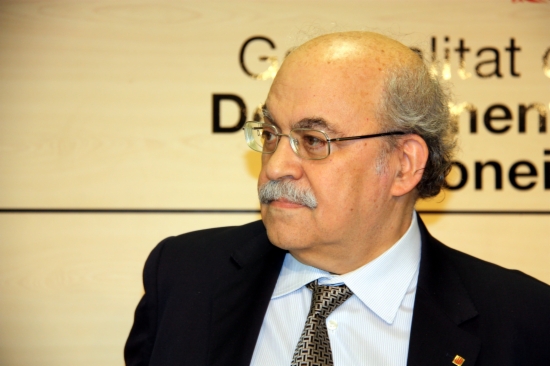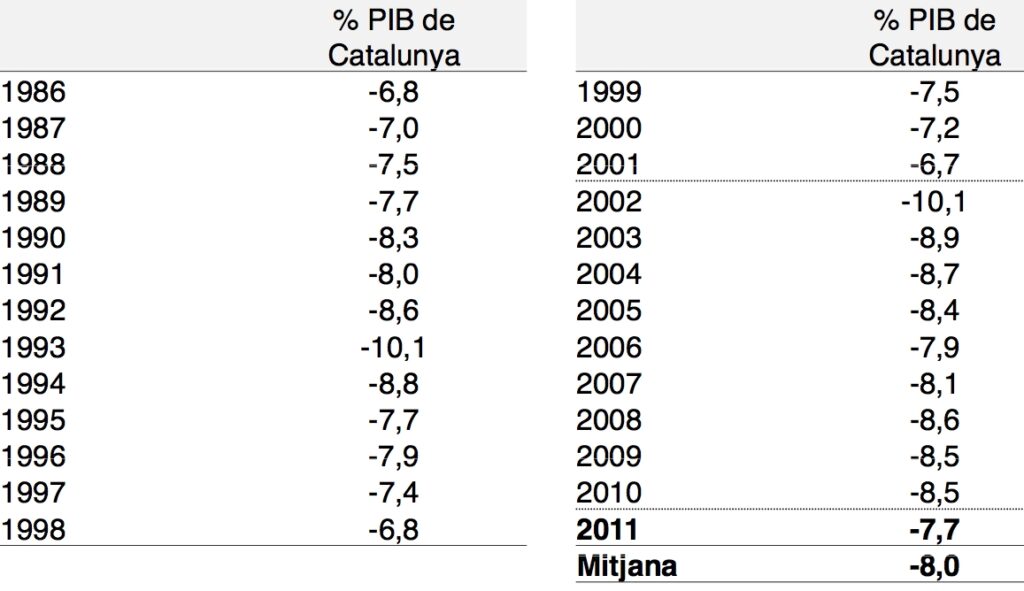13.06.2014 - 10:45
The fiscal deficit between Catalonia and Spain has been constant over the course of the last twenty-six years, from 1986 to 2011. The annual average is 8% of Catalan GDP, according to figures from the Catalan government. The latest data was published yesterday, as Minister of Finance and Knowledge Andreu Mas-Colell presented the assessment of the fiscal balance sheets for 2011, which reveals a fiscal deficit of Catalonia with respect to the Spanish State of 15 billion euros, that is, more than two thousand euros per capita that go to Madrid and don’t come back. The size of the fiscal deficit over the past three decades is overwhelming: more than 245 billion euros that have left Catalonia and stayed in Spain.
Two years ago, the Catalan Government began to present data about the fiscal deficit since 1986: these are neutralized data, in millions of euros and as a percentage of Catalan GDP. “Neutralization” means that they are adjusted to erase the effect of Spanish public sector’s financial variability, which makes it possible to compare one year with another. Consequently, the fiscal deficit in 1986 was 6.5 billion euros or 6.8% of the GDP (each Catalan contributed 1076 euros to the State which didn’t return), and in 2011 that figure rose to 15 billion euros, 7.7% of Catalan GDP.
2011 data
Catalonia sent 15 billion euros to Madrid in 2011 which did not return, according to the fiscal balance calculations published yesterday. The 2011 fiscal balance, like in previous years, was calculated using two standard methodologies: the cash flow method and the benefit approach. According to the cash flow method, Catalonia contributes 19.2% of the total income of the state administration but receives only 14% of the state’s total spending. Therefore, Catalonia contributes with a proportion that is bigger to its weight in the Spanish State’s GDP (18.6% in 2011) and in contrast, receives a fraction of spending that isn’t even as large as Catalonia’s percentage of the population with respect to the state as a whole: 16%.
The cash flow method measures the economic impact generated by the state administration’s activity in a territory and, as the government points out, is especially important in times of financial crisis and unemployment. According to this method, Catalonia’s fiscal deficit in 2011 was 15 billion euros.
With the benefit approach, spending on state-wide fixtures is also considered to benefit individual territories. For example, the civil servants in the State’s Ministry of Education, including Minister Wert, live in Madrid and mostly spend in Madrid. Under the benefit approach, the cost of the Ministry is considered to benefit all the people in the Spanish State. Or the Prado Museum in Madrid, which in 2013 alone received 38 million euros in State money (compared with 11 million for all cultural institutions combined in Barcelona), 25% of which is said to benefit residents outside of Madrid. With the benefit approach, Catalonia’s fiscal deficit was 11 billion euros, that is 5.7% of the Catalan GDP.
“Both approaches are correct,” says economist Elisenda Paluzie, “that’s why the Generalitat calculates them both. The important question now is to determine what additional resources we’ll have with independence. The answer is an average of the two methods, around 7%. We would save by reducing redundancy—not having to pay for superfluous ministries in Madrid, for example—and also benefit the Catalan economy by additional spending in Catalonia to make up for some services no longer provided for by Spain.”
Latest calculations
The last publication of Catalonia’s fiscal deficit was a year ago, with data from 2010. In that year, the fiscal deficit with respect to the Spanish State was 16.5 billion euros, or 8.5% of Catalan GDP.
The fiscal balance measures the redistribution effect between territories due to the Spanish Administration’s fiscal policies, that is, it shows the difference between what the State spends in a given area and the amount of income that it takes from that same area in order to finance the central State budget. There is a “fiscal deficit” when the income taken from a territory is more than what is spent for the citizens in that territory, that is when there is a net exit of fiscal resources.




